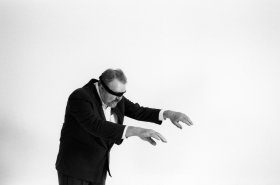The Projection Project
dal 13/12/2006 al 24/2/2007
Segnalato da
Marie Jose
Burki
Marc De Blieck
Rodney Graham
Pierre Huyghe
Kristina Ianatchkova
Vitto Valentinov
Timothe Ingen-Housz
Yeondoo Jung
Andre Kruysen
Bertrand Lavier
Bruce Nauman
Timothy Quay
Joost Rekveld
Matthew Stokes
Fiona Tan
Krassimir Terziev
Ana Torfs
Paul Van
Hoeydonck
Benjamin Verdonck
Cerith Wyn Evans
Thomas Zummer
Edwin Carels
Mark Kremer
Dieter Roelstraete
Thomas Zummer
Joost Rekveld
Edwin Carels
13/12/2006
The Projection Project
Museum van Hedendaagse Kunst Antwerpen M HKA, Antwerp
Durven denken, durven dromen. International group exhibition. In art and reflections on visual culture, projection occurs in all kinds of formats. Its many applications come from a development in which sometimes very different fields interact: physics, geometry, cartography, optics, psychology, the fine arts and show business. Curated by Mark Kremer, Edwin Carels, Dieter Roelstraete.

Durven denken, durven dromen
Curated by Mark Kremer, Edwin Carels, Dieter Roelstraete
In art and reflections on visual culture, projection occurs in all kinds of formats.
Its many applications come from a development in which sometimes very different
fields interact: physics, geometry, cartography, optics, psychology, the fine arts
and show business. As a concept however, projection has not been thematized all that
much; it links mathematical and cultural conceptualization, operations of the
unconscious and of an active mind.
The Projection Project durven denken, durven dromen [dare to think, dare to dream]
is taking place in a media landscape where a new paradigm emerges. Today we
experience a farewell to various analogue image technologies. As a result of the
digital revolution many methods sanctified by the tradition of modern art, such as
slide- and film projection, will get into disuse. The art world’s response to this
is one of lucid nostalgia and militant identification; in contemporary art slide-
and film projection will for sure remain important media for a while, but these can
hardly be dissociated from the effect of looking back melancholy at an epoch and a
technology that once was.
But the historical breakdown of projection as technology means that we have reached
a point in time where projection does not longer need to be thought in narrow
technical or technological terms. Relevant here is the socio-political undertone of
projection as a collective event or as a project of a future community. Now that
projection is losing its technological servitude, the concept can regain its
metaphorical power. Our hypothesis therefore is that artists at this juncture once
more tackle and regauge the artistic concept of ‘projection.’
What does current projection art tell us? The Projection Project investigates how
art offers alternatives to a culture of escapism typified by an immense presence of
phantasmagorical representations, images carried by technology that are
filtering/masking our daily reality. In current projection art we see, amongst
others, an interest in technique as intoxicator by deconstructing technology in its
operations on the human psyche. Here is a relation with psychedelic art from the 2nd
half of the ’60, with one difference: the understanding that today’s reality itself
often is already hallucinatory. Recent projection art also differs from the
phantasmagories that dominate today’s visual culture, in that it redefines the
implicit ambition of the term: projection as a project, a visionary image, radiating
an expectation about the future. Historical consciousness is repaired, after all
projection as a pure utopia is a reaction to the present, a product of its time and
rooted in a past.
The event wants to be a thoughtful enterprise in itself, a promising
method to [re]think and show the potential of the act of projection. In its
ambition, the project is a co-operation of three curators [Mark Kremer, Edwin
Carels, Dieter Roelstraete] and three institutions [MuHKA, IFFR, NAi publishers].
This unison of visions and practices led to an exhibition, a publication, and a film
programme.
The cinematographic part of the show, with presentations in
MuHKA_media, comprises three retrospectives with work by David Lynch, Werner Herzog
and Abbas Kiarostami respectively, three evenings in which the curators give their
personal view of the possibilities of film as projection medium.
As an epilogue, MuHKA also presents Rear Windows, comprising works by Anri Sala,
Julie Morel and Michael Snow.
Participating artists
Marie Jose,Burki, Marc De Blieck, Rodney Graham, Pierre Huyghe, Kristina
Ianatchkova, Vitto Valentinov, Timothe Ingen-Housz, Yeondoo Jung,
Andre Kruysen, Bertrand Lavier, Bruce Nauman, Timothy Quay, Joost Rekveld, Matthew Stokes, Fiona Tan, Krassimir Terziev, Ana Torfs, Paul Van Hoeydonck, Benjamin Verdonck, Cerith Wyn Evans and Thomas Zummer.
Image: Ana Torfs, Trompe-l'oeil, 2003
Opening: 14 dec. 2006
MuHKA
Museum van Hedendaagse Kunst Antwerpen
Leuvenstraat 32 - Antwerpen



